LINCOLN NAVIGATOR 2014 Owner's Guide
Manufacturer: LINCOLN, Model Year: 2014, Model line: NAVIGATOR, Model: LINCOLN NAVIGATOR 2014Pages: 506, PDF Size: 5.72 MB
Page 31 of 506
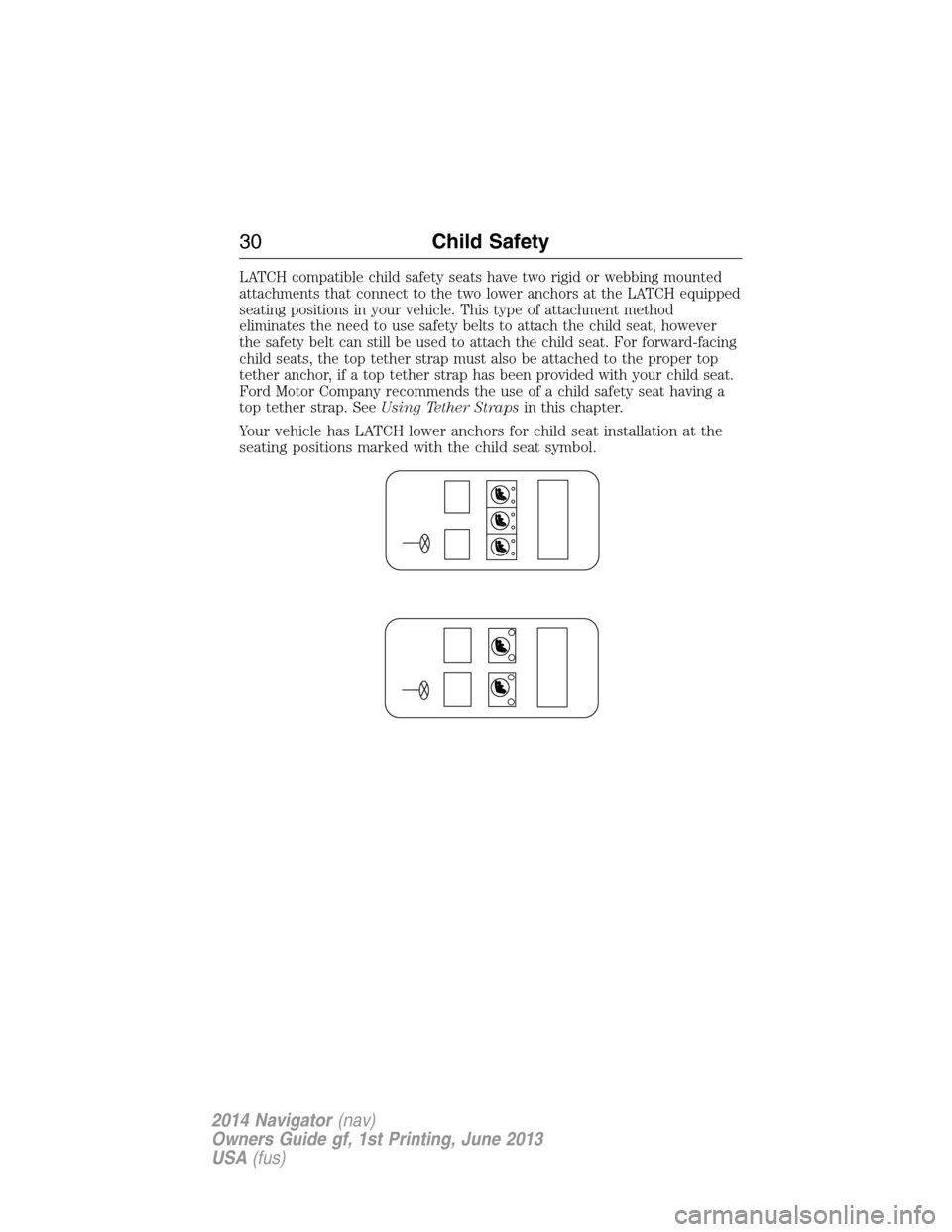
LATCH compatible child safety seats have two rigid or webbing mounted
attachments that connect to the two lower anchors at the LATCH equipped
seating positions in your vehicle. This type of attachment method
eliminates the need to use safety belts to attach the child seat, however
the safety belt can still be used to attach the child seat. For forward-facing
child seats, the top tether strap must also be attached to the proper top
tether anchor, if a top tether strap has been provided with your child seat.
Ford Motor Company recommends the use of a child safety seat having a
top tether strap. SeeUsing Tether Strapsin this chapter.
Your vehicle has LATCH lower anchors for child seat installation at the
seating positions marked with the child seat symbol.
30Child Safety
2014 Navigator(nav)
Owners Guide gf, 1st Printing, June 2013
USA(fus)
Page 32 of 506
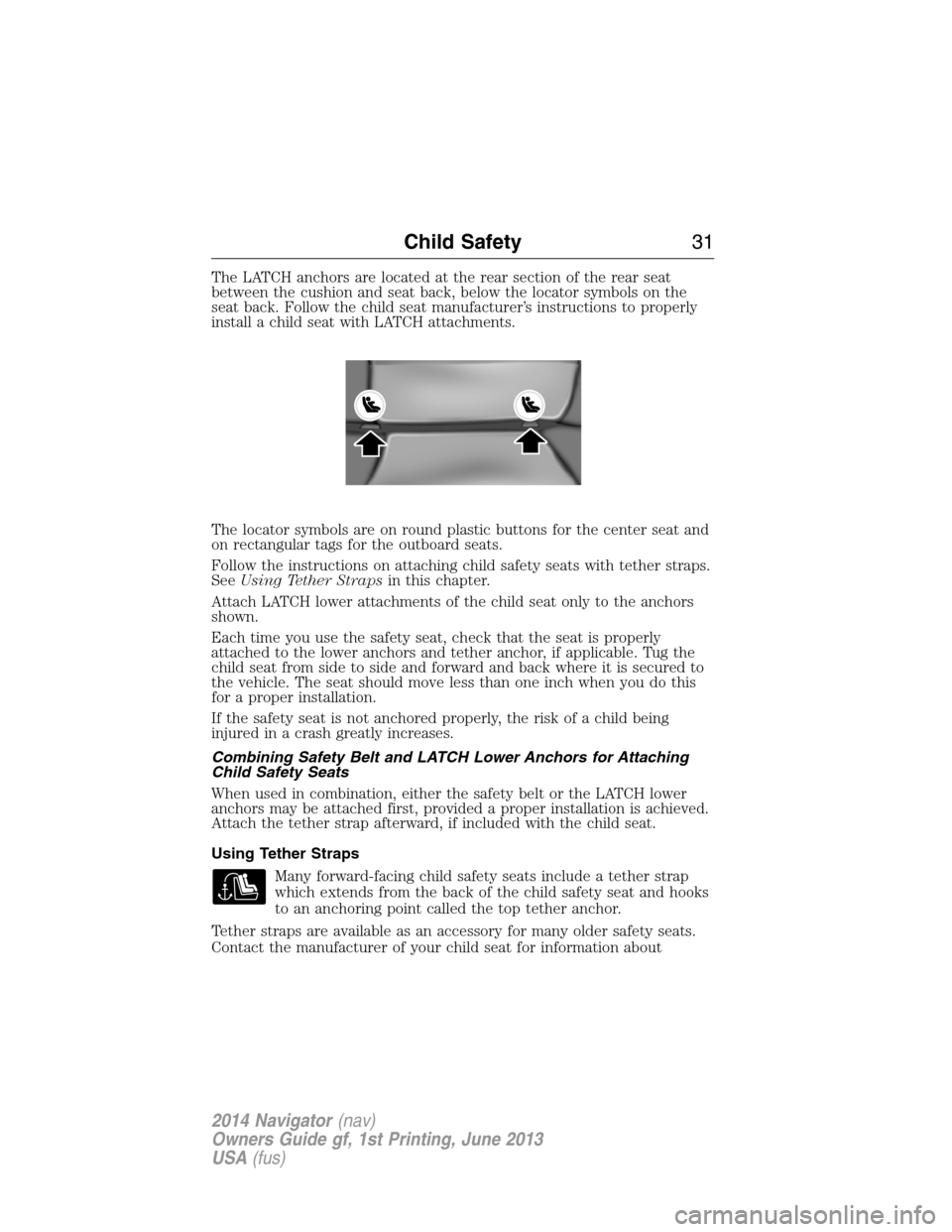
The LATCH anchors are located at the rear section of the rear seat
between the cushion and seat back, below the locator symbols on the
seat back. Follow the child seat manufacturer’s instructions to properly
install a child seat with LATCH attachments.
The locator symbols are on round plastic buttons for the center seat and
on rectangular tags for the outboard seats.
Follow the instructions on attaching child safety seats with tether straps.
SeeUsing Tether Strapsin this chapter.
Attach LATCH lower attachments of the child seat only to the anchors
shown.
Each time you use the safety seat, check that the seat is properly
attached to the lower anchors and tether anchor, if applicable. Tug the
child seat from side to side and forward and back where it is secured to
the vehicle. The seat should move less than one inch when you do this
for a proper installation.
If the safety seat is not anchored properly, the risk of a child being
injured in a crash greatly increases.
Combining Safety Belt and LATCH Lower Anchors for Attaching
Child Safety Seats
When used in combination, either the safety belt or the LATCH lower
anchors may be attached first, provided a proper installation is achieved.
Attach the tether strap afterward, if included with the child seat.
Using Tether Straps
Many forward-facing child safety seats include a tether strap
which extends from the back of the child safety seat and hooks
to an anchoring point called the top tether anchor.
Tether straps are available as an accessory for many older safety seats.
Contact the manufacturer of your child seat for information about
Child Safety31
2014 Navigator(nav)
Owners Guide gf, 1st Printing, June 2013
USA(fus)
Page 33 of 506

ordering a tether strap, or to obtain a longer tether strap if the tether
strap on your safety seat does not reach the appropriate top tether
anchor in the vehicle.
Some of the rear seats of your vehicle are equipped with built-in tether
strap anchors located behind the seats as described below.
In the third row center seating position, the tether anchor is a loop at
the bottom of the seat back.
The tether strap anchors in your vehicle are in the following positions
(shown from top view).
•Second row bench seat
•Second row bucket seats
Attach the tether strap only to the appropriate tether anchor as shown.
The tether strap may not work properly if attached somewhere other
than the correct tether anchor.
Once the child safety seat has been installed using either the safety belt,
the lower anchors of the LATCH system, or both, you can attach the top
tether strap.
If you install a child seat with rigid LATCH attachments, and have
attached the top tether strap to the proper top tether anchor, do not
tighten the tether strap enough to lift the child seat off the vehicle seat
cushion when the child is seated in it. Keep the tether strap just snug
without lifting the front of the child seat. Keeping the child seat just
touching the vehicle seat gives the best protection in a severe crash.
32Child Safety
2014 Navigator(nav)
Owners Guide gf, 1st Printing, June 2013
USA(fus)
Page 34 of 506
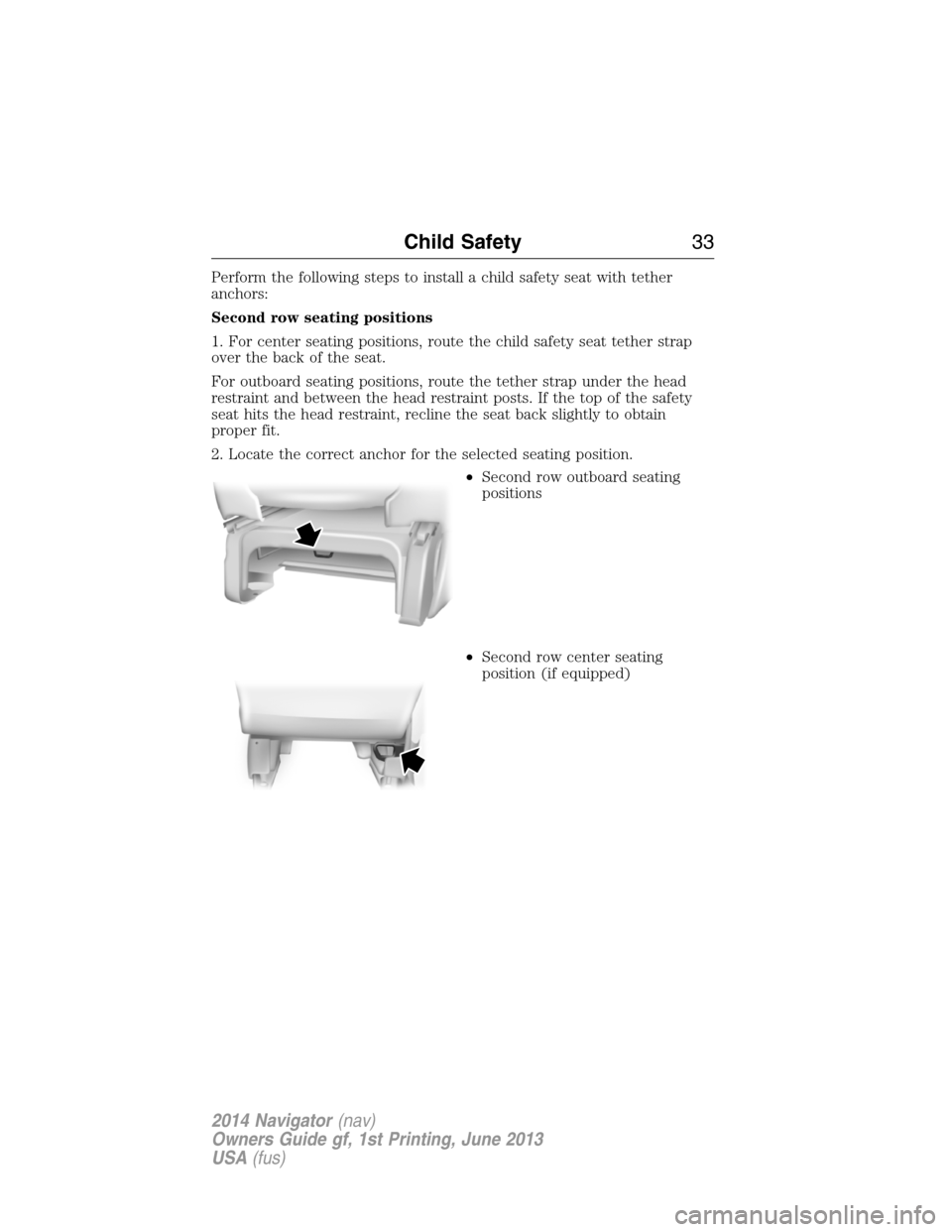
Perform the following steps to install a child safety seat with tether
anchors:
Second row seating positions
1. For center seating positions, route the child safety seat tether strap
over the back of the seat.
For outboard seating positions, route the tether strap under the head
restraint and between the head restraint posts. If the top of the safety
seat hits the head restraint, recline the seat back slightly to obtain
proper fit.
2. Locate the correct anchor for the selected seating position.
•Second row outboard seating
positions
•Second row center seating
position (if equipped)
Child Safety33
2014 Navigator(nav)
Owners Guide gf, 1st Printing, June 2013
USA(fus)
Page 35 of 506
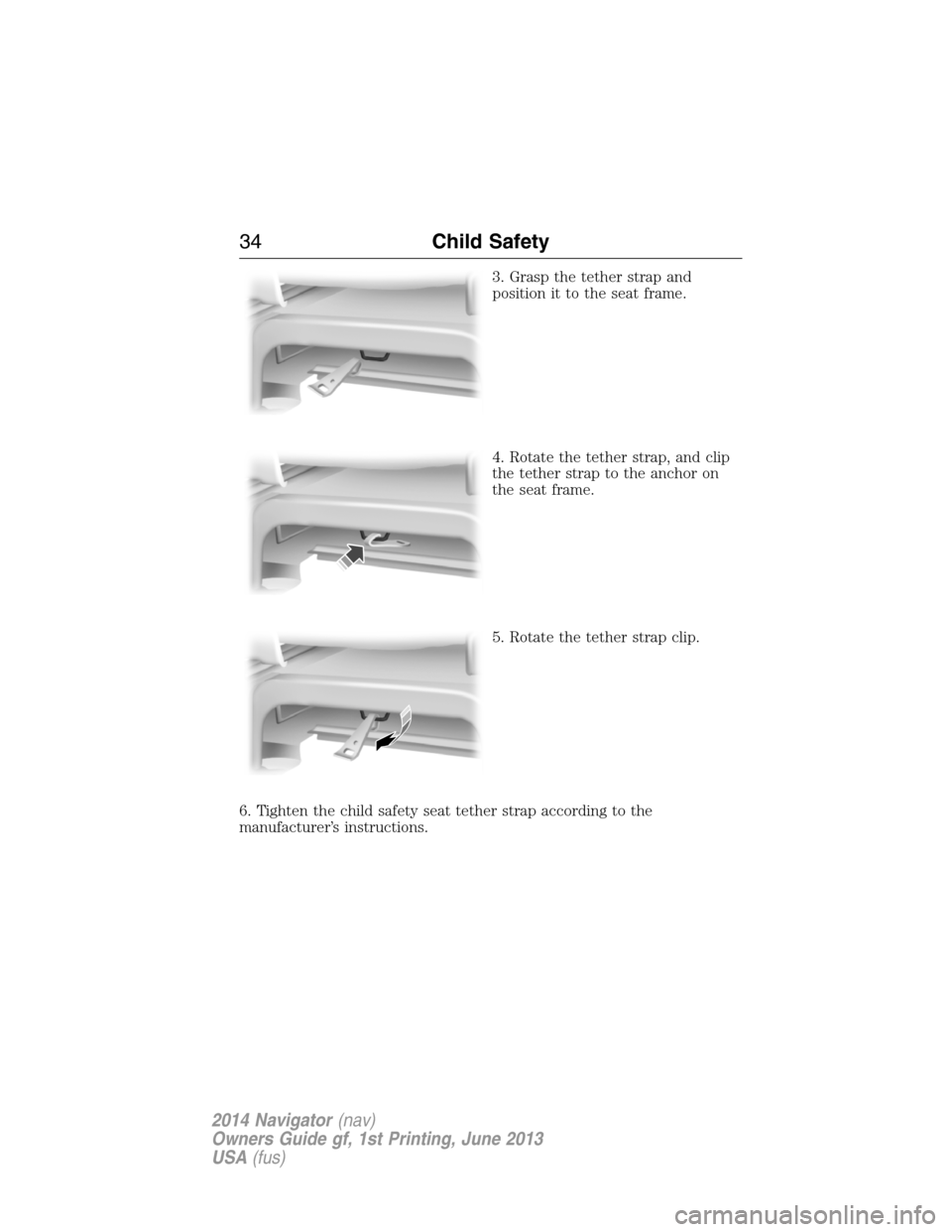
3. Grasp the tether strap and
position it to the seat frame.
4. Rotate the tether strap, and clip
the tether strap to the anchor on
the seat frame.
5. Rotate the tether strap clip.
6. Tighten the child safety seat tether strap according to the
manufacturer’s instructions.
34Child Safety
2014 Navigator(nav)
Owners Guide gf, 1st Printing, June 2013
USA(fus)
Page 36 of 506
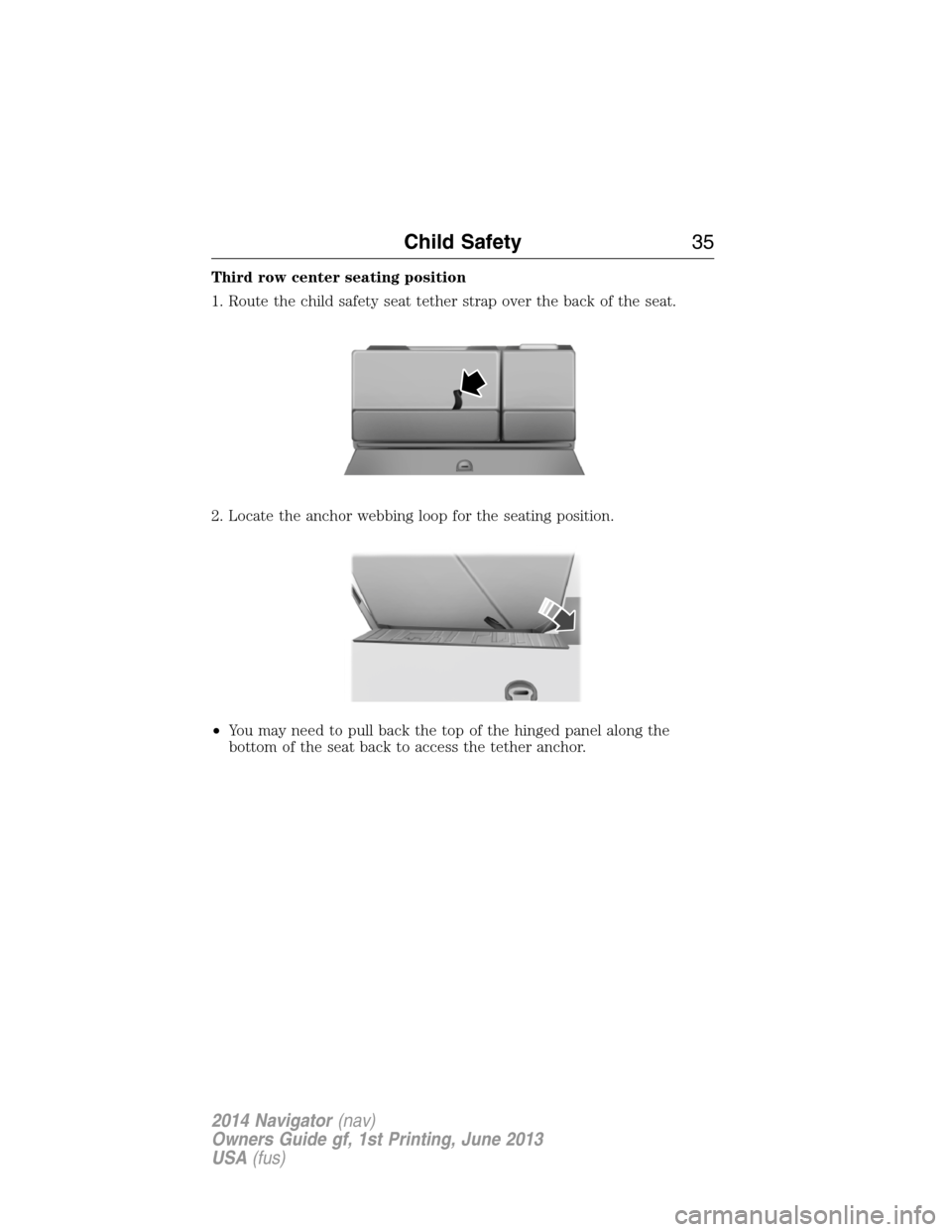
Third row center seating position
1. Route the child safety seat tether strap over the back of the seat.
2. Locate the anchor webbing loop for the seating position.
•You may need to pull back the top of the hinged panel along the
bottom of the seat back to access the tether anchor.
Child Safety35
2014 Navigator(nav)
Owners Guide gf, 1st Printing, June 2013
USA(fus)
Page 37 of 506
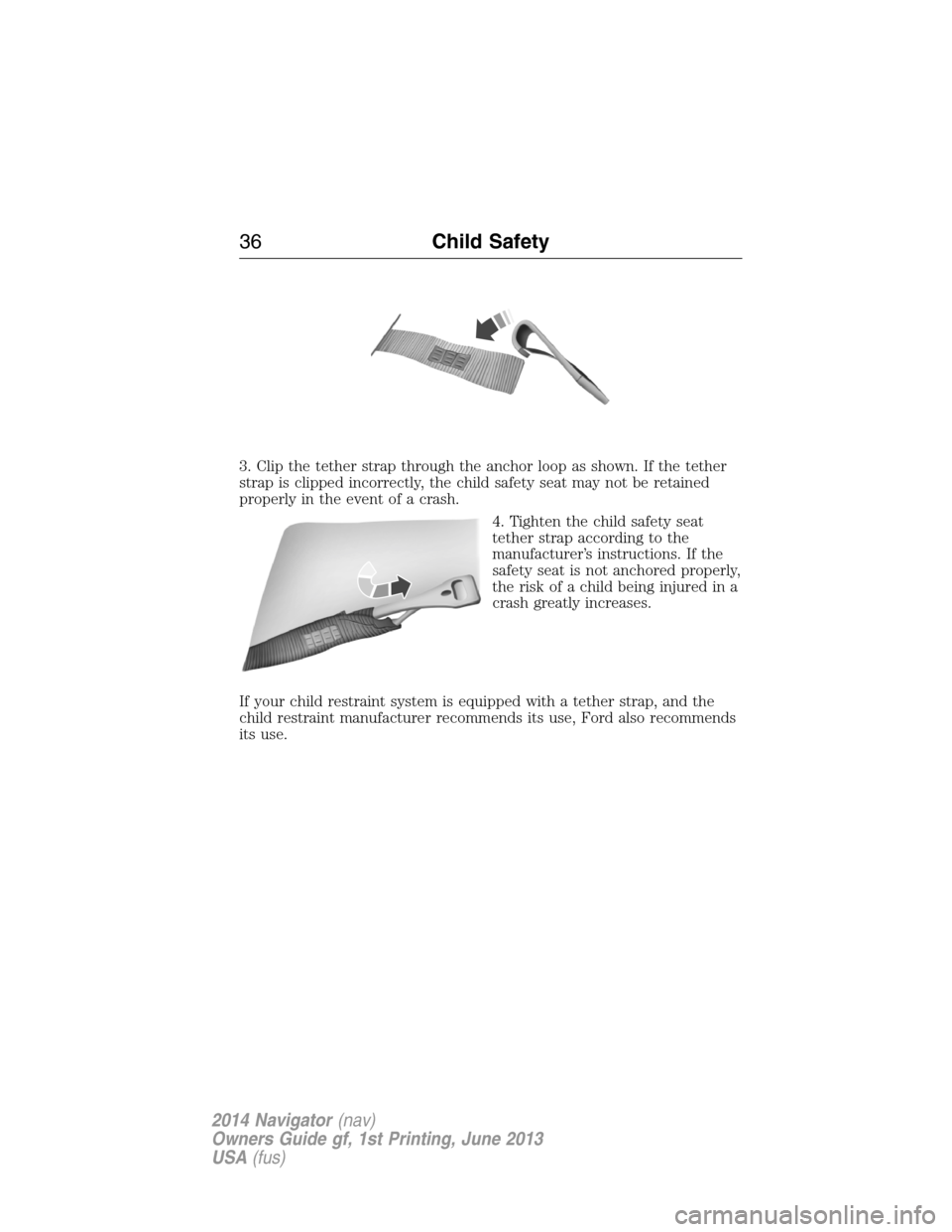
3. Clip the tether strap through the anchor loop as shown. If the tether
strap is clipped incorrectly, the child safety seat may not be retained
properly in the event of a crash.
4. Tighten the child safety seat
tether strap according to the
manufacturer’s instructions. If the
safety seat is not anchored properly,
the risk of a child being injured in a
crash greatly increases.
If your child restraint system is equipped with a tether strap, and the
child restraint manufacturer recommends its use, Ford also recommends
its use.
36Child Safety
2014 Navigator(nav)
Owners Guide gf, 1st Printing, June 2013
USA(fus)
Page 38 of 506
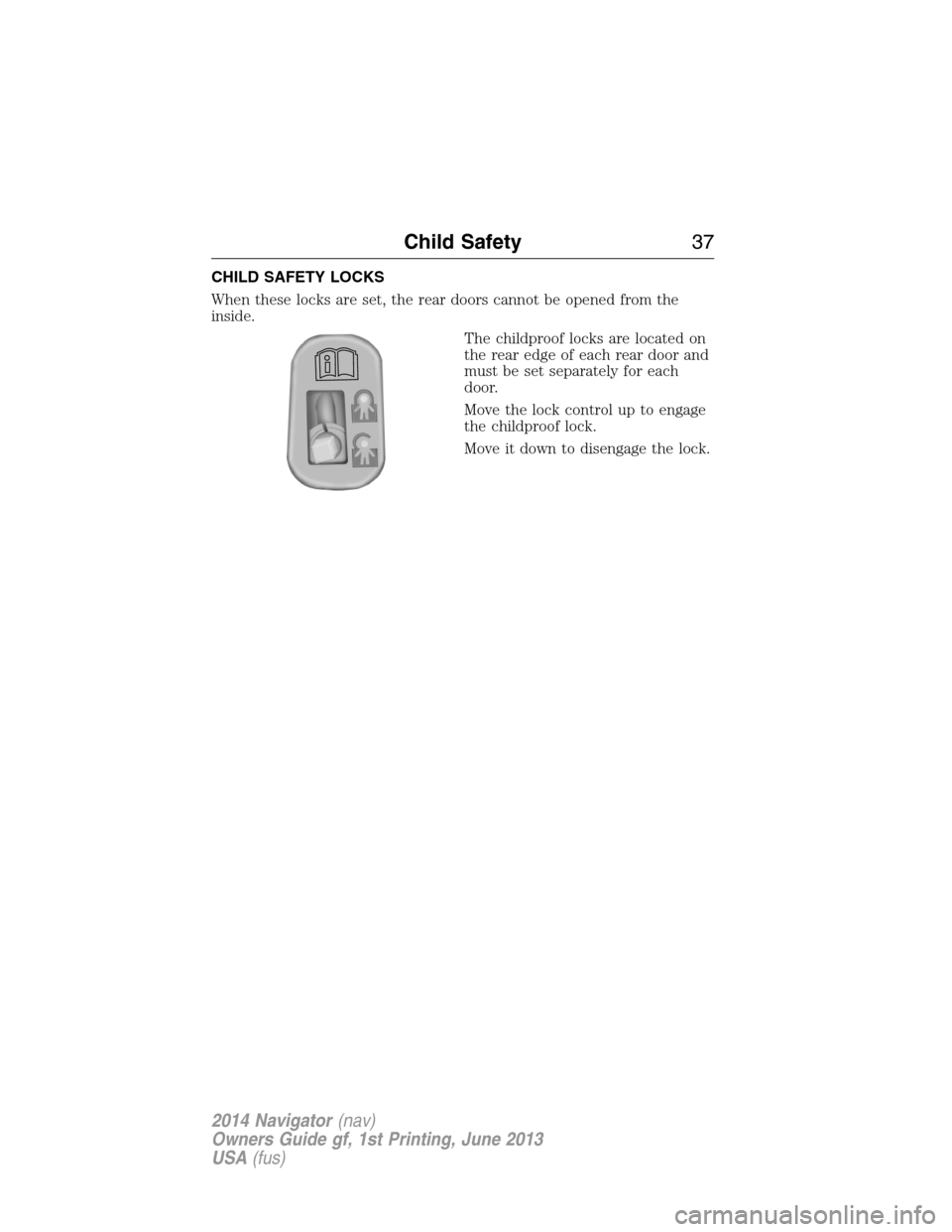
CHILD SAFETY LOCKS
When these locks are set, the rear doors cannot be opened from the
inside.
The childproof locks are located on
the rear edge of each rear door and
must be set separately for each
door.
Move the lock control up to engage
the childproof lock.
Move it down to disengage the lock.
Child Safety37
2014 Navigator(nav)
Owners Guide gf, 1st Printing, June 2013
USA(fus)
Page 39 of 506
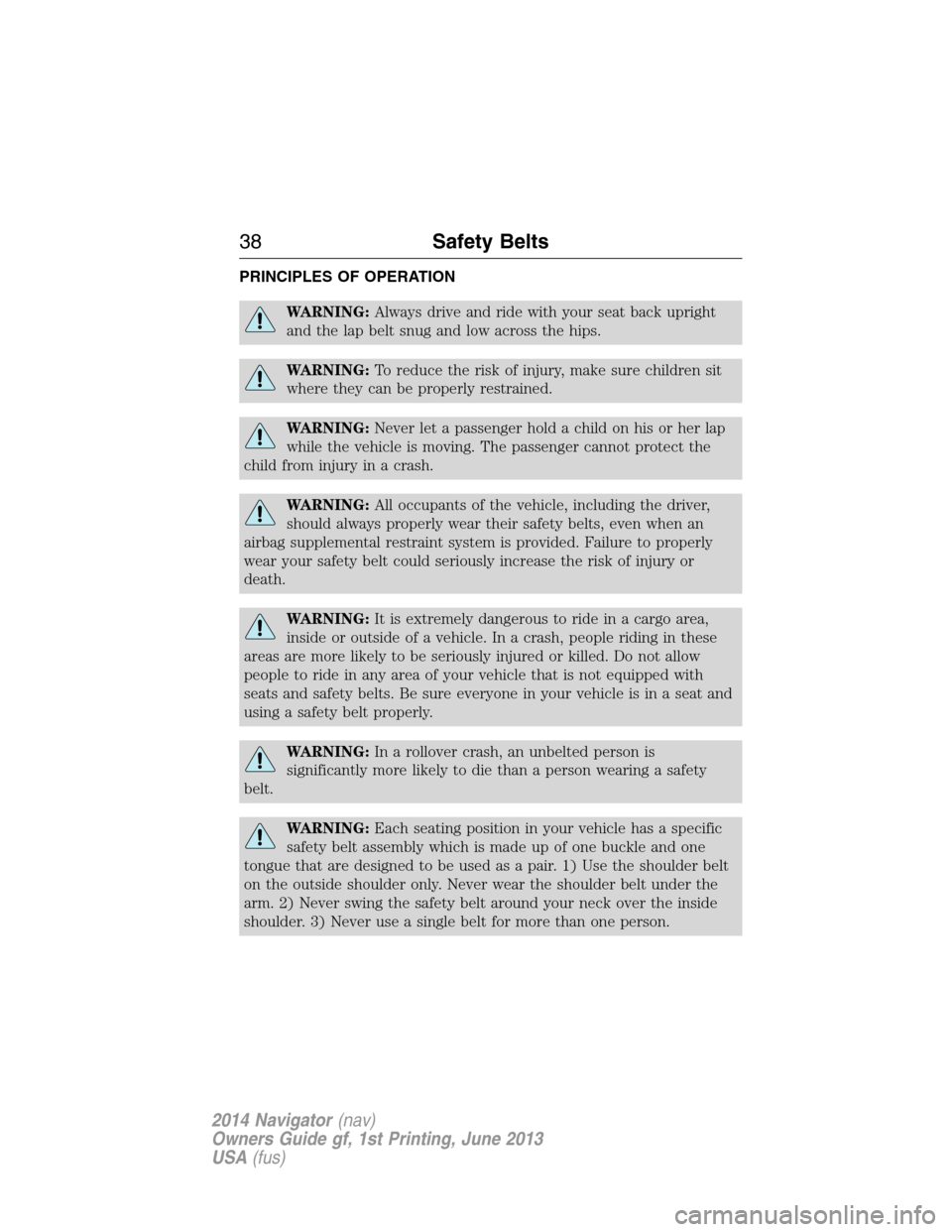
PRINCIPLES OF OPERATION
WARNING:Always drive and ride with your seat back upright
and the lap belt snug and low across the hips.
WARNING:To reduce the risk of injury, make sure children sit
where they can be properly restrained.
WARNING:Never let a passenger hold a child on his or her lap
while the vehicle is moving. The passenger cannot protect the
child from injury in a crash.
WARNING:All occupants of the vehicle, including the driver,
should always properly wear their safety belts, even when an
airbag supplemental restraint system is provided. Failure to properly
wear your safety belt could seriously increase the risk of injury or
death.
WARNING:It is extremely dangerous to ride in a cargo area,
inside or outside of a vehicle. In a crash, people riding in these
areas are more likely to be seriously injured or killed. Do not allow
people to ride in any area of your vehicle that is not equipped with
seats and safety belts. Be sure everyone in your vehicle is in a seat and
using a safety belt properly.
WARNING:In a rollover crash, an unbelted person is
significantly more likely to die than a person wearing a safety
belt.
WARNING:Each seating position in your vehicle has a specific
safety belt assembly which is made up of one buckle and one
tongue that are designed to be used as a pair. 1) Use the shoulder belt
on the outside shoulder only. Never wear the shoulder belt under the
arm. 2) Never swing the safety belt around your neck over the inside
shoulder. 3) Never use a single belt for more than one person.
38Safety Belts
2014 Navigator(nav)
Owners Guide gf, 1st Printing, June 2013
USA(fus)
Page 40 of 506
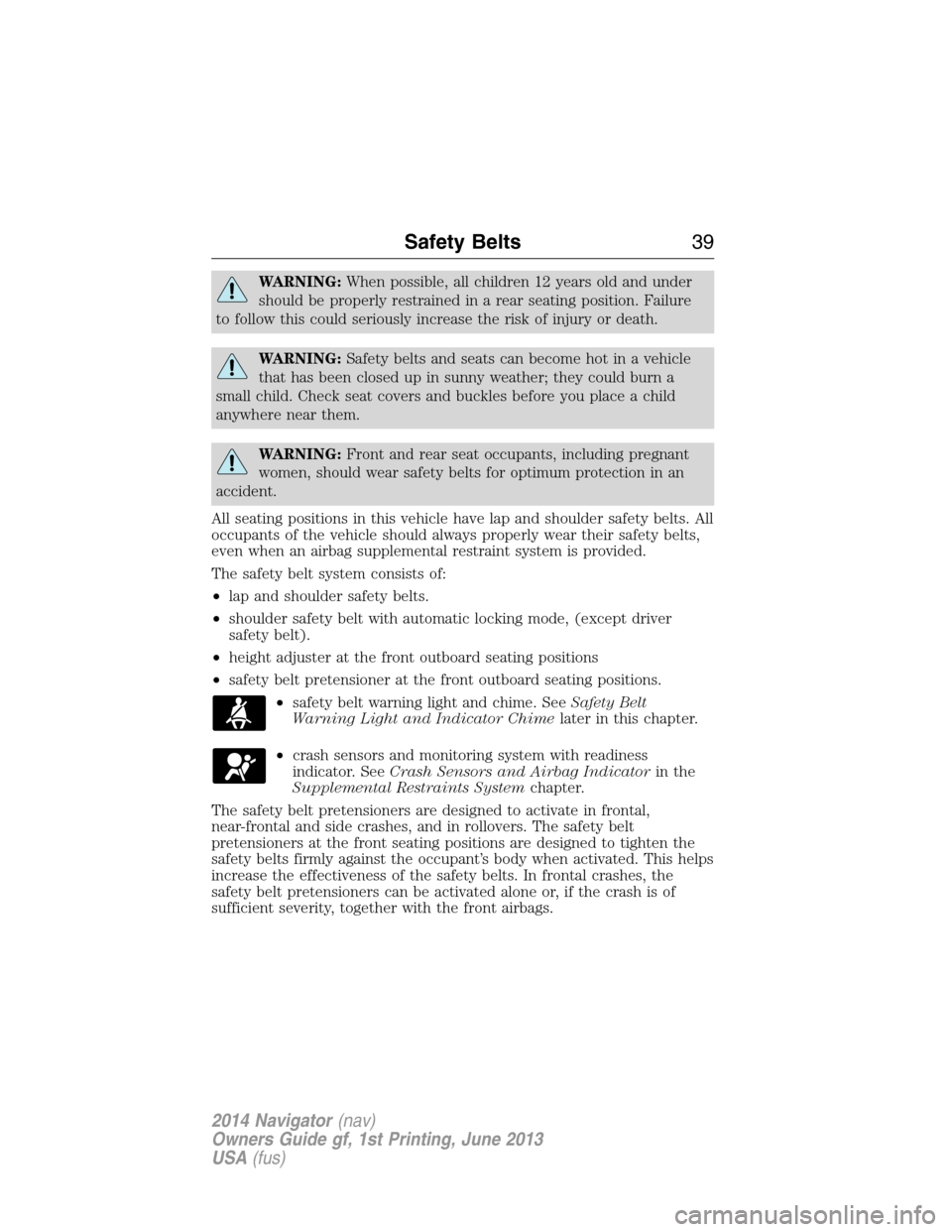
WARNING:When possible, all children 12 years old and under
should be properly restrained in a rear seating position. Failure
to follow this could seriously increase the risk of injury or death.
WARNING:Safety belts and seats can become hot in a vehicle
that has been closed up in sunny weather; they could burn a
small child. Check seat covers and buckles before you place a child
anywhere near them.
WARNING:Front and rear seat occupants, including pregnant
women, should wear safety belts for optimum protection in an
accident.
All seating positions in this vehicle have lap and shoulder safety belts. All
occupants of the vehicle should always properly wear their safety belts,
even when an airbag supplemental restraint system is provided.
The safety belt system consists of:
•lap and shoulder safety belts.
•shoulder safety belt with automatic locking mode, (except driver
safety belt).
•height adjuster at the front outboard seating positions
•safety belt pretensioner at the front outboard seating positions.
•safety belt warning light and chime. SeeSafety Belt
Warning Light and Indicator Chimelater in this chapter.
•crash sensors and monitoring system with readiness
indicator. SeeCrash Sensors and Airbag Indicatorin the
Supplemental Restraints Systemchapter.
The safety belt pretensioners are designed to activate in frontal,
near-frontal and side crashes, and in rollovers. The safety belt
pretensioners at the front seating positions are designed to tighten the
safety belts firmly against the occupant’s body when activated. This helps
increase the effectiveness of the safety belts. In frontal crashes, the
safety belt pretensioners can be activated alone or, if the crash is of
sufficient severity, together with the front airbags.
Safety Belts39
2014 Navigator(nav)
Owners Guide gf, 1st Printing, June 2013
USA(fus)